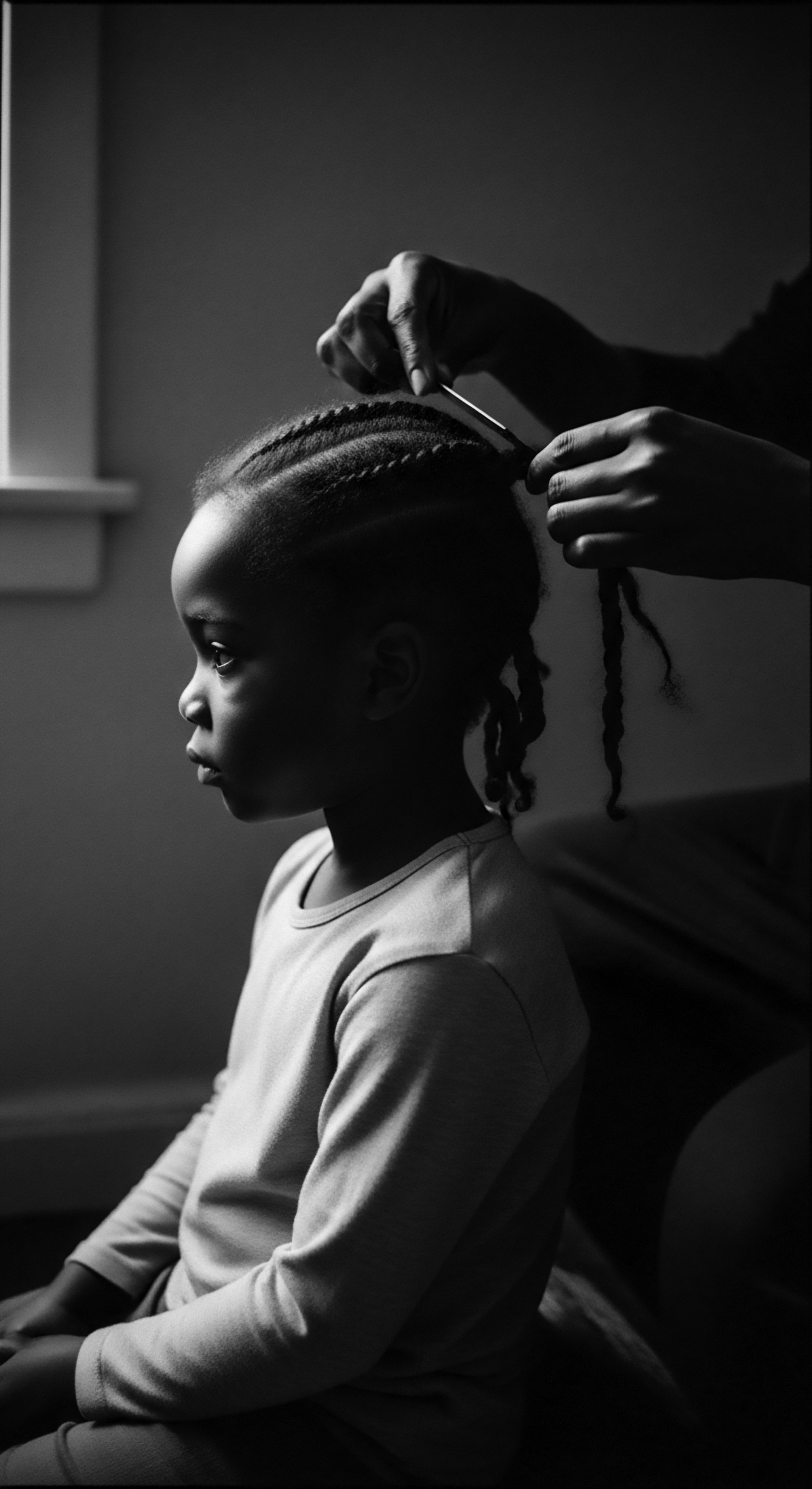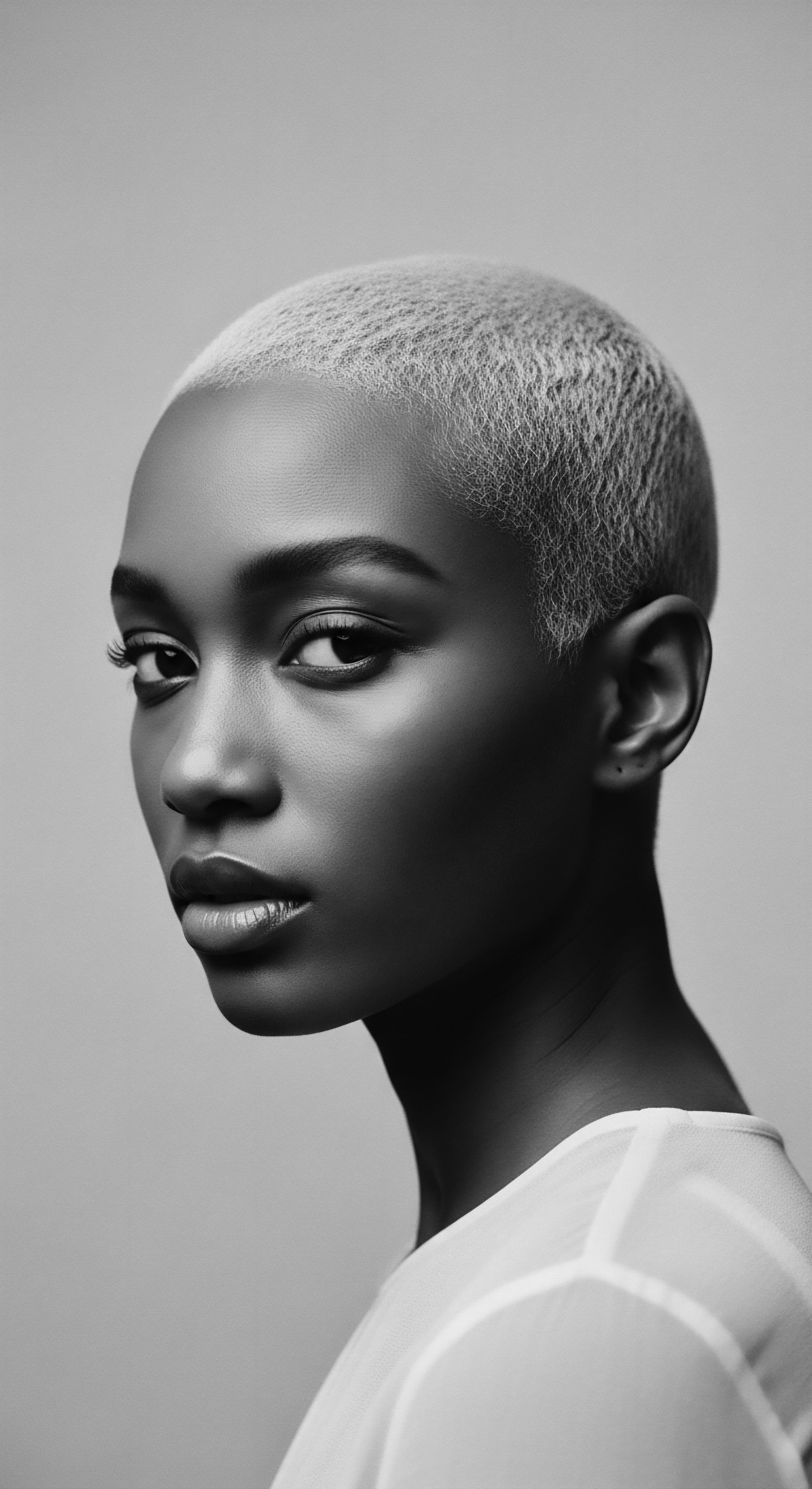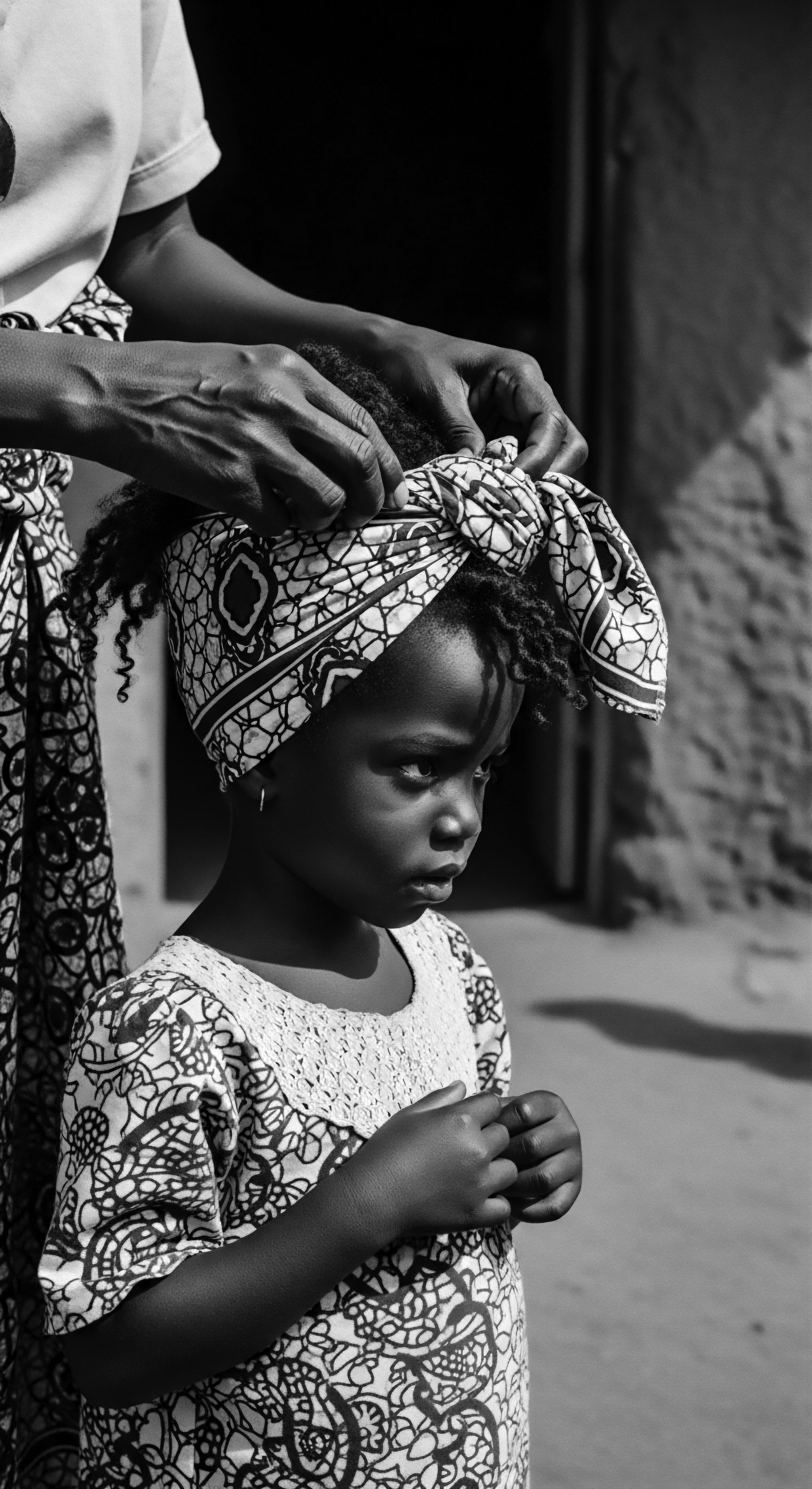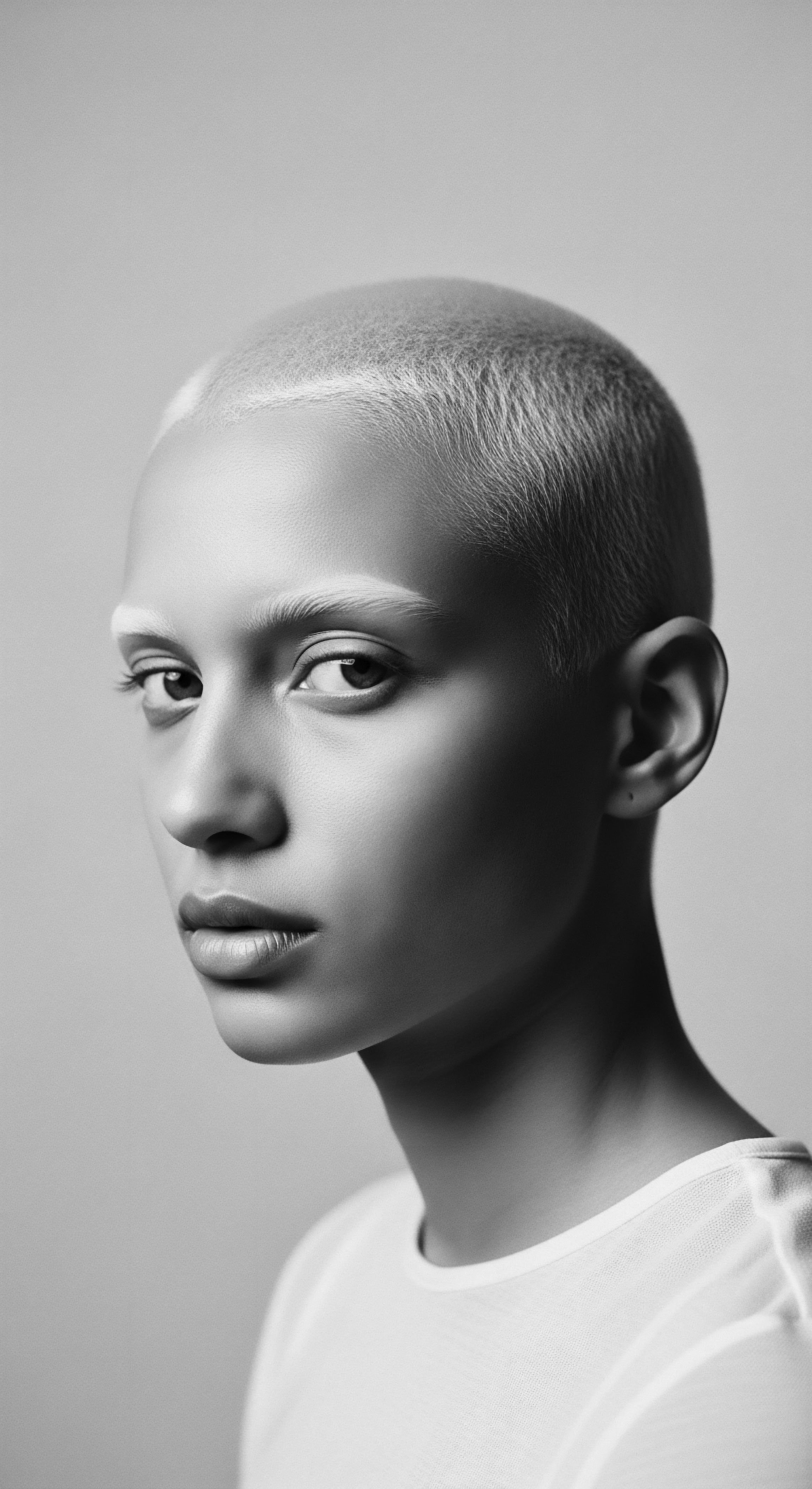
Fundamentals
The definition of marital status, within the rich expanse of textured hair heritage, extends far beyond mere legal designation. This concept, often a simple administrative checkmark in contemporary society, transforms into a profound communal declaration, a visual language woven into the very strands of an individual’s being. From the earliest ancestral practices, hair has served not only as an adornment, a shield against the elements, or a canvas for artistic expression; it has communicated identity, lineage, and indeed, one’s standing within the social collective.
The interpretation of marital status, seen through the sensitive lens of textured hair traditions, acknowledges this deeper import. It encompasses the recognized transitions a person experiences in their intimate relationships and communal roles, particularly how these shifts have been historically and culturally acknowledged, celebrated, or even mandated through the grooming, styling, and adornment of hair across Black and mixed-race communities.
Consider the elemental biology of the hair itself. Each coil, each curve, holds the memory of its progenitor, carrying within its structure the very genetic blueprints of lineage. This inherent connection to ancestry makes hair a sacred repository of heritage, a living, tangible link to those who came before. When a change in marital status occurred in historical contexts, it was often a profound shift not just for the individual, but for families and entire communities.
Hair, therefore, became a visible signifier, a public announcement, a ceremonial mark of this transition. It was a societal compass, indicating whether a person was entering a new phase of life, taking on new responsibilities, or signaling their availability within the communal structure. This explanation moves beyond a superficial understanding, grounding the term in the very bedrock of cultural practices that saw the body, particularly hair, as a living archive of one’s journey and affiliations.
This foundational understanding allows us to appreciate how deeply intertwined hair and social identity truly were. The meaning of marital status, in this context, was not abstract; it found concrete expression in the daily rituals of hair care and styling. It was a lived experience, acknowledged and reinforced by the communal gaze and the wisdom passed down through generations.

Ancestral Declarations in Adornment
In many ancestral African societies, the styling of hair was an eloquent form of non-verbal communication, a visual glossary of social roles and life stages. The way a woman or man wore their hair could signify their age, their lineage, their readiness for partnership, or their current marital state. This societal recognition of hair as a communicative tool meant that changes in relationship status were often accompanied by distinct alterations in hair presentation.
For young women reaching marriageable age, specific styles might emerge, perhaps more elaborate or adorned, signaling their eligibility. Once married, the hair might transform again, adopting new arrangements or incorporating particular ornaments that denoted their new status as a wife, a mother, or an elder within the community. These transformations were not arbitrary; they were deliberate, often ritualistic, and held deep communal significance. This visual language provided immediate information about an individual’s place within the societal structure, fostering harmony and understanding.
Hair, in many traditional Black communities, served as a vibrant communal lexicon, visually declaring a person’s social and marital standing.
The historical context of hair as a social marker is vital for comprehending the depth of marital status beyond its modern, simplified definition. It shows us that hair, especially textured hair, was not merely a biological attribute. It was a dynamic medium through which communities expressed and maintained their social order, celebrating rites of passage and recognizing the evolving relationships among their members. This historical truth offers a richer interpretation of marital status, linking it directly to the living heritage of hair practices.

Intermediate
Moving into a more intermediate contemplation, the definition of marital status, as it intertwines with textured hair heritage, reveals itself as a complex interplay of personal identity, communal expectations, and ancestral continuity. It is a delineation of one’s standing within a shared lineage, often marked by the subtle shifts in hair presentation that speak volumes without uttering a word. This understanding acknowledges that for Black and mixed-race communities, particularly those with deep roots in African traditions, the journey of marriage or partnership was, and in many ways remains, a communal affair, where the individual’s physical self—especially the crowning glory—becomes a public canvas for these deeply personal transitions.
The significance of hair in reflecting marital status transcends mere legal contracts. It reflects a cultural practice where identity is intrinsically linked to visible markers. This involves not only formal ceremonies but also the intimate, everyday care practices passed from elder to youth.
Such care rituals, often communal in nature, reinforced the individual’s place within the family and broader society, including their marital identity. The very act of hair braiding, often a shared experience among women, could be a moment of intergenerational transmission of knowledge, where stories, customs, and the meaning of different styles – including those signaling marital readiness or status – were shared.

The Tender Thread of Communal Recognition
Historically, the transition into marriage in many African societies was not solely a personal agreement between two individuals; it involved the assent and involvement of entire families and clans. This communal aspect extended to the presentation of the individual, particularly in their hair. Hair styling often became a tangible representation of this societal recognition, a tender thread connecting personal commitment to collective identity.
Consider the Mende people of Sierra Leone , for whom hair is deeply sacred, a conduit to spiritual energy and a vessel for identity. Within the revered Sande society, a powerful women’s initiation association, young girls undergo rigorous training that prepares them for womanhood, domestic responsibilities, and indeed, marriage. A critical element of this initiation and subsequent bridal ceremonies involves specific, intricate hair styling.
For the Mende, intricate bridal hair designs were not merely beautiful; they were sacred declarations of a woman’s readiness for marriage and new communal responsibilities.
During the Sande initiation process and culminating in wedding rites, women often adorned their hair in elaborate braided styles, meticulously crafted to convey their transition from girlhood to the esteemed status of a wife. These styles were not static; they were dynamic expressions, sometimes incorporating shells, beads, or other elements that held symbolic meaning. This precise declaration, observed and understood by the entire community, solidified the woman’s new marital status and her integration into a different societal role.
The visual statement made by her hair ensured that her change in status was widely acknowledged and respected, serving as a powerful communication of her new position within the social order. (Shaw, 1998)
| Aspect of Marital Status Declaration of Status |
| Traditional/Ancestral Hair Practices Hair styles, adornments, and rituals explicitly communicated marital eligibility, betrothal, or married state (e.g. specific braids, headwraps). |
| Contemporary/Diasporic Hair Reflections Hair choices still reflect personal statements, but direct communication of marital status through style is less common. Personal expression or cultural pride takes precedence. |
| Aspect of Marital Status Communal Recognition |
| Traditional/Ancestral Hair Practices A public, visible acknowledgment by the community, fostering social order and role understanding. |
| Contemporary/Diasporic Hair Reflections Personal milestone, celebrated more privately. Hair may be styled for celebrations (weddings), but the direct societal message is diminished. |
| Aspect of Marital Status Intergenerational Transmission |
| Traditional/Ancestral Hair Practices Hair care and styling knowledge tied to life stages, including marriage, passed down from elders. |
| Contemporary/Diasporic Hair Reflections Ancestral hair care rituals passed down, but the specific link to marital status is less explicit; more focused on general hair wellness and cultural connection. |
| Aspect of Marital Status Understanding this historical continuum helps connect our modern hair journeys to the profound wisdom of our ancestors, acknowledging hair's enduring role as a vessel of identity and tradition. |

A Language of Fibers and Forms
The precise meanings attributed to various hairstyles varied significantly across the vast tapestry of African cultures, yet the underlying principle of hair as a language remained constant. In some communities, a woman with uncovered hair might have been seen as unmarried or in a specific life stage, while a married woman would always don a headwrap or intricate braids. The number of braids, the direction they faced, or the inclusion of certain ornaments could all contribute to this silent, yet potent, communication about one’s intimate affiliations.
The impact of colonialism and the transatlantic enslavement shattered many of these overt, communal expressions of identity through hair. Yet, even in the most oppressive circumstances, the spirit of this connection endured. Hair, often concealed or forcibly shorn, retained its internal significance as a marker of self, a quiet rebellion against dehumanization, and a whispered memory of cultural practices, including those that once openly declared marital status. The resilience of textured hair, its very resistance to easy manipulation, became a physical manifestation of the enduring spirit of a people determined to retain their heritage, even as outward markers of marital status became obscured or redefined by new realities.
This intermediate interpretation moves beyond a mere listing of facts. It begins to trace the profound journey of how the definition and meaning of marital status, in its visible manifestation through hair, traversed historical upheavals, adapting and persevering as a subtle yet significant aspect of Black and mixed-race cultural heritage. It highlights the deeply ingrained understanding that hair is a living legacy, capable of holding and conveying stories of connection, partnership, and belonging across generations.

Academic
The academic understanding of marital status, when examined through the rigorous lens of textured hair heritage, transcends a simplistic legal or sociological categorization. This elucidation considers marital status as a dynamic sociocognitive construct, its meaning deeply embedded within cultural semiotics, ancestral practices, and the lived experiences of individuals within specific ethno-historical contexts. From this scholarly perspective, the term refers to the formally recognized or communally acknowledged state of an individual’s intimate partnership, profoundly articulated and often validated through somatic markers, particularly the meticulous presentation and adornment of hair within Black and mixed-race communities. The delineation here extends to understanding how this concept, through the centuries, has influenced societal roles, economic structures, and the very transmission of cultural knowledge related to hair care, especially for those whose heritage links back to the complex and diverse traditions of the African continent.
The academic analysis necessitates an exploration of how variations in marital status—be it singlehood, betrothal, marriage, widowhood, or polygamous unions—were historically articulated through the complex visual syntax of hair. This understanding requires a deep dive into anthropological and ethnobotanical studies, examining the specific tools, ingredients, and ritualistic gestures that accompanied these transitions. It necessitates a critical appraisal of how colonial impositions and post-slavery realities fragmented, yet failed to entirely erase, these deeply ingrained cultural practices. The long-term consequences of such disruptions are still being understood, impacting contemporary self-perception and the reclamation of ancestral hair wisdom.

Echoes from the Source ❉ Hair as a Communal Declaration of Union
In myriad pre-colonial African societies, hair styling was not merely an aesthetic endeavor; it represented a sophisticated system of non-verbal communication, a communal lexicon of identity and social standing. The concept of marital status, in this historical framework, was intrinsically linked to these visual cues. Ethnographic research consistently reveals that specific hair designs, head wraps, or the incorporation of particular adornments—such as cowrie shells, beads, or natural fibers—served as potent indicators of a person’s eligibility for marriage, their status as a bride, or their established position within a marital union. This form of communication was both prescriptive and descriptive, guiding social interactions and reinforcing communal norms surrounding partnership.
For instance, among certain groups, an unmarried woman might wear her hair in distinct, simple braids or styles, signifying her availability. Upon marriage, her hair might undergo a profound transformation, adopting more elaborate, perhaps weightier styles, often incorporating symbolic elements. This change was not just a personal choice; it was a societal declaration, understood and respected by all members of the community.
Such practices were often rooted in cosmological beliefs, with hair itself seen as a connection to the divine, to ancestors, and to life forces, making its transformation in alignment with marital status a sacred act. The very essence of these traditions lies in their capacity to render abstract social constructs tangible through the medium of hair, a practice that sustained communal cohesion and provided a clear visual framework for social roles.
The enduring wisdom of these ancestral approaches to marital status, often centered on the meticulous creation of distinctive hair forms, finds intriguing echoes and expansions in our contemporary scientific comprehension of human social signaling. While modern neurobiology or social psychology may not directly study specific braid patterns, they confirm the fundamental human need for external markers of internal states and group affiliations. The ancient practices demonstrate an intuitive grasp of these very principles.

The Interconnected Incidences ❉ Marital Status, Hair, and Wellness Paradigms
The interconnectedness between marital status and hair heritage extends into domains of holistic wellness and mental health, particularly for individuals of African descent. Historically, the elaborate care and styling of hair were often communal acts, especially for significant life events like marriage. These rituals fostered social bonding, provided emotional support, and facilitated the transmission of cultural knowledge. The shared experience of preparing a bride’s hair, for example, was a moment of collective wisdom-sharing, a grounding experience that affirmed her identity and her place within the lineage as she entered a new phase of her life.
The disruption of these practices through enslavement and subsequent socio-economic pressures had profound long-term consequences. The forcible shaving of heads during the Middle Passage, or the later suppression of traditional hairstyles, systematically dismantled these visible markers of identity and marital status. This act severed the very fabric of communal recognition, impacting self-perception and contributing to a devaluation of textured hair that persisted for centuries. The loss of hair as a public declaration of marital status, among other social roles, contributed to a broader sense of disenfranchisement and a disconnect from ancestral practices.
The current reclamation of textured hair as a symbol of pride and heritage, therefore, offers a powerful counter-narrative. It is a movement that subtly re-establishes some of the historical connections between hair and identity, including the implicit understanding of life transitions. While contemporary hair choices may not explicitly declare marital status in the same way as traditional practices, the conscious decision to wear natural textures or ancestral styles often signifies a deeper connection to heritage, self-acceptance, and a subtle declaration of autonomy and self-worth that can indeed influence personal relationships and expressions of partnership.
- Ceremonial Braids ❉ In numerous West African cultures, specific braided patterns or extensions were exclusively reserved for brides, signifying their passage into married life and their readiness to assume the roles of wife and mother.
- Adorned Wraps ❉ Married women in various Southern African communities, such as the Zulu and Ndebele, often wore elaborate head wraps and adornments that indicated their marital status, sometimes even reflecting the number of children they had borne.
- Unbound Hair for Singlehood ❉ Conversely, the absence of specific styles or head coverings often communicated youth or unmarried status, allowing for different expressions of hair until a marital union was established.
- Post-Marital Styles ❉ Some communities adopted distinct styles for women once they became wives, emphasizing their new role within the household and community, often less about adornment and more about practicality and dignity.

The Unbound Helix ❉ Shifting Meanings and Enduring Legacy
The evolution of “marital status” as a concept, particularly in the diaspora, reveals a continuous negotiation between ancestral traditions and imposed realities. The legalistic definition, largely a construct of Western systems, often stands in stark contrast to the fluid, communally validated understanding of partnership that existed in many pre-colonial African societies. While the overt, hair-based declarations of marital status diminished under colonial rule and enslavement, the underlying cultural reverence for hair, its connection to lineage, and its symbolic weight persevered.
This persistence is not merely nostalgic; it is a profound testament to the resilience of heritage. Even today, though perhaps not explicitly declaring marital status, the act of maintaining and celebrating textured hair is, for many, a deeply personal affirmation of identity, a connection to ancestral strength. The careful attention to hair, using traditional ingredients or techniques, becomes a form of self-care rooted in historical wisdom, supporting mental and emotional well-being that undeniably contributes to healthier interpersonal relationships, including partnerships. It is a subtle but powerful echo of those ancient practices where hair spoke volumes about one’s place in the world, including their intimate connections.
The academic investigation of marital status within this context offers a unique perspective on social constructs and their material manifestations. It reveals that definitions are not static; they are shaped by cultural forces, historical events, and the persistent desire to communicate identity. The hair, in its diverse forms and enduring significance, remains a powerful medium through which the story of marital status—from its most ancient communal declarations to its most modern, personal expressions—continues to unfold, carrying the profound wisdom of generations.
The very act of choosing to wear one’s hair in its natural state, or in styles reminiscent of ancestral practices, can be a quiet statement of belonging, a connection to a lineage that values self-acceptance and authenticity. This connection, while not always explicitly about marital status, certainly influences the foundation of any partnership by fostering a strong sense of self. It speaks to the enduring legacy of hair as a profound communicator of identity, a living link to the collective past, and a powerful shaper of individual presence within the world.
| Era/Context Pre-Colonial African Societies |
| Hair's Role in Marital Status Direct, visual indicators; specific styles, adornments, and rituals marked transitions into marriage, widowhood, or other partnership states. |
| Societal Implications for Identity Clear social hierarchy and communal understanding. Hair reinforced an individual's recognized role and duties within the collective. |
| Era/Context Era of Enslavement |
| Hair's Role in Marital Status Suppression of traditional styles; forced shaving or uniform presentation; hair became a site of resistance or concealment. |
| Societal Implications for Identity Disruption of communal identity markers; struggle for self-definition; hair as a symbol of defiance or hidden heritage. |
| Era/Context Post-Slavery to Mid-20th Century |
| Hair's Role in Marital Status Emphasis on assimilation; "straight" hair as a marker of respectability; traditional marital hair markers largely absent. |
| Societal Implications for Identity Hair choices often linked to socio-economic mobility; personal identity subsumed under societal pressures; ancestral links weakened. |
| Era/Context Late 20th Century to Present (Diaspora) |
| Hair's Role in Marital Status Reclamation of natural hair; ancestral styles re-emerging; hair as a personal statement of heritage, pride, and wellness. |
| Societal Implications for Identity Personal agency in identity expression; hair as a connection to roots and community; marital status signaled more through personal expression than rigid style. |
| Era/Context Tracing these historical shifts illuminates the resilience of textured hair heritage and its persistent capacity to convey profound aspects of self and social connection, even as the specific language of marital status evolved. |

Reflection on the Heritage of Marital Status
The exploration of marital status through the textured hair heritage of Black and mixed-race communities offers a profound meditation on identity, connection, and the enduring power of cultural memory. We have journeyed from the earliest communal declarations, where a single braid or carefully chosen ornament spoke volumes about a woman’s entry into partnership, to the quiet resilience of hair as a repository of ancestral wisdom even in times of profound upheaval. The meaning, in this context, has always been more than a legal declaration; it is a soulful acknowledgment of a bond, a relationship, a place within the vibrant continuum of lineage.
Hair, in its magnificent variations, from the tightest coil to the loosest wave, remains a living testament to this heritage. It reminds us that our stories are etched not just in historical records or oral traditions, but also in the very fibers that spring from our crowns. The ritual of hair care, whether it is the tender detangling, the careful application of ancestral oils, or the sculpting of styles that honor our foremothers, carries within it the echoes of countless generations who understood hair as a sacred extension of self. These practices, once perhaps explicitly tied to declaring marital status, now offer a broader form of affirmation ❉ a declaration of self-love, a connection to our roots, and a deep appreciation for the journey of our hair and our being.
The definition of marital status, therefore, when viewed through Roothea’s lens, is not a fixed point but a flowing current, reflecting the ongoing adaptation of cultural practices and the persistent relevance of heritage. It is a reminder that what we do with our hair, how we choose to present it to the world, can carry unspoken histories, convey personal truths, and honor the unbreakable bonds that tie us to our past, present, and future selves. This continuum, where personal choice meets ancestral wisdom, allows us to appreciate the true significance of hair as a conduit for profound declarations of identity, relationship, and belonging.

References
- Shaw, Rosalind. (1998). “Gender, Secrecy, and the Spirit of Power ❉ A Study of the Sande Society of the Mende of Sierra Leone.” University of Pennsylvania Press.
- Thompson, Robert Farris. (1993). “Face of the Gods ❉ Art and Altars of Africa and the African Americas.” Museum for African Art.
- Byrd, Ayana D. and Lori L. Tharps. (2014). “Hair Story ❉ Untangling the Roots of Black Hair in America.” St. Martin’s Press.
- Patton, Sharon. (2006). “African-American Hair as Culture and History.” Praeger.
- Gale, Dennis E. and Patricia G. Holley. (1999). “African American Dress and Adornment ❉ A Cultural Perspective.” Kendall Hunt Publishing Company.
- Mercer, Kobena. (1994). “Welcome to the Jungle ❉ New Positions in Black Cultural Studies.” Routledge.
- hooks, bell. (1992). “Black Looks ❉ Race and Representation.” South End Press.
- Bundles, A’Lelia Perry. (2001). “On Her Own Ground ❉ The Life and Times of Madam C.J. Walker.” Lisa Drew Books.
- Opoku-Agyemang, Naana Jane. (2005). “Sande ❉ A Historical Re-evaluation of the Institution.” Journal of African Studies.
- Abiodun, Rowland. (2014). “Yoruba Art and Language ❉ Seeking the African in African Art.” Cambridge University Press.
